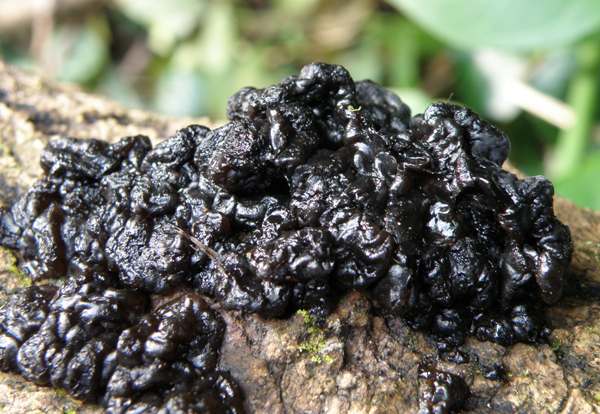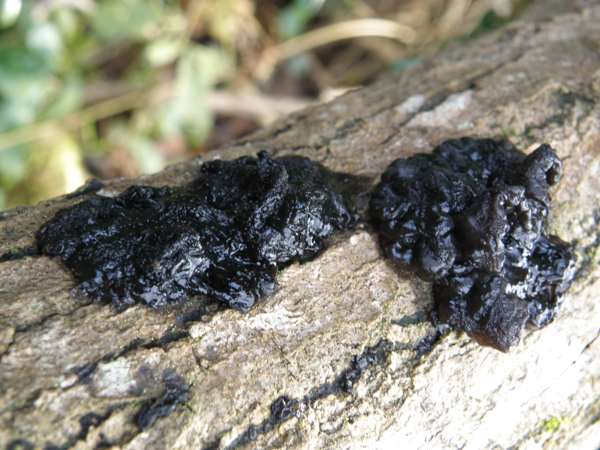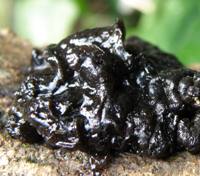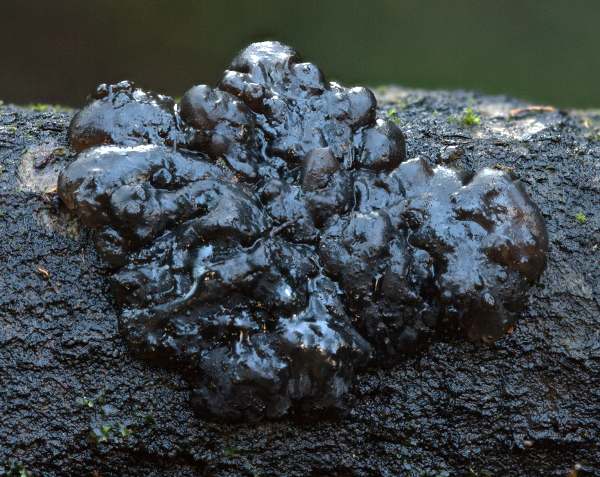Exidia nigricans (With.) P. Roberts - Warlock's Butter
Phylum: Basidiomycota - Class: Tremellomycetes - Order: Auriculariales - Family: Auriculariaceae
Distribution - Taxonomic History - Etymology - Identification - Culinary Notes - Reference Sources

Exidia nigricans, recently given the English name Warlock's Butter, is similar to (and very often confused with) Exidia glandulosa - commonly referred to as Witches' Butter or Black Witch's Butter, because of its butter-like consistency when wet and its sombre colour; however, Exidia nigricans has brain-like folds rather than being made up of irregular blocks with flattish facets. This jelly fungus can occur throughout the year; it appears on dead hardwood, particularly Beech, Ash and Hazel, but very rarely oaks. (Oaks are the favoured host of Exidia glandulosa.)

Distribution
Exidia nigricans occurs throughout Britain and Ireland as well as in most parts of mainland Europe. On a worldwide scale this jelly fungus is also widely distributed throughout the northern hemisphere including parts of North America.
Taxonomic history
The taxonomy of this jelly fungus is unclear, and some authorities still place it in the order Tremellales. In the USA the genus Exidia is placed under the family Auriculariaceae rather than Exidiaceae.
The basionym dates from a 1776 publication by British botanist and mycologist William Withering (1741 - 1799). It was the Dutch mycologist Marinus Anton Donk (1908 - 1972) who in 1966 redefined the Exidia genus, clearly separating Exidia plana (now Exidia nigricans) from its lookalike Exidia glandulosa, with which it had been treated previously as a single species under the name Exidia glandulosa.
British mycologist Peter Roberts suggested that Exidia plana was an invalid name, and that Tremella nigricans With. was the earliest valid name for this species. The official name in the Fungus Records Database for Britain and Ireland now has the preferred name of this species listed as Exidia nigricans.
Synonyms of Exidia nigricans include Exidia plana (Donk) and Tremella plana F.H. Wigg., and Tremella nigricans With.

Etymology
Exidia, the generic name, means exuding or staining, and both seem appropriate because these jelly fungi do look like exudations when moist and like dark stains on wood when they dry out. I believe the specific epithet plana comes from the Latin adjective planus, which means level, flat or even; if so then perhaps this isn't the most descriptive of epithets!
Identification guide
 |
FruitbodyShiny black when wet, turning olive brown and shrivelling to a warty crust during very dry weather; gelatinous (but noticeably firmer than Tremella mesenterica, the Yellow Brain, and most other jelly fungi). Individual fruitbodies blend into one another like the folds of a brain; composite 'blobs' are typically 5 to 15 cm across. Dried and shrivelled fruitbodies are revived in wet weather and regain their expanded shape and gelatinous texture. |
 |
SporesAllantoid (sausage-shaped), smooth, 14-19 x 4.5-5.5µm; inamyloid. Spore printWhite. |
Odour/taste |
Not distinctive. |
Habitat & Ecological role |
Saprobic, on dead and decaying hardwood - mainly Beech, Ash and Hazel but very occasionally also oaks. |
Season |
Throughout the year in Britain and Ireland but most prevalent in late autumn, winter and early spring. |
Similar species |
Exidia glandulosa comprises irregular flattish-faceted separate blocks of black jelly-like material. Tremella mesenterica is yellow and has a brain-like structure. |

Culinary Notes
This jelly fungus is of dubious edibility, and in any case it is too insubstantial to be worth collecting for food. We therefore - Class it as being of no culinary value.
Reference Sources
Fascinated by Fungi, 2nd Edition, Pat O'Reilly 2016, reprinted by Coch-y-bonddu Books in 2022.
British Mycological Society. English Names for Fungi
Dictionary of the Fungi; Paul M. Kirk, Paul F. Cannon, David W. Minter and J. A. Stalpers; CABI, 2008
Taxonomic history and synonym information on these pages is drawn from many sources but in particular from the British Mycological Society's GB Checklist of Fungi.
Acknowledgements
This page includes pictures kindly contributed by David Kelly.
Fascinated by Fungi. Back by popular demand, Pat O'Reilly's best-selling 450-page hardback book is available now. The latest second edition was republished with a sparkling new cover design in September 2022 by Coch-y-Bonddu Books. Full details and copies are available from the publisher's online bookshop...


